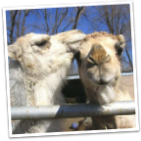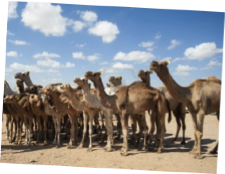
About Me
Dromedary camels stand over 7 feet tall, and weigh as much as 1,800 pounds. They have many unique adaptations that allow them to thrive in the harsh desert environment. The camel’s most distinct feature is their hump. Contrary to popular belief, the camel’s hump is not filled with water. It contains a hard fat that can be broken down and utilized as energy. A camel can, however, store water in their cells. Their cells are shaped differently than other mammals, and can swell far beyond their original size. They can then use this water to avoid becoming dehydrated when no drinking water is available. It is said that a camel can go up to 30 days without a drink. Then when do they do drink, they can consume up to 30 gallons at one time. They can do this because one of their many stomachs has the ability to absorb water through it into their body much like a sponge to quickly rehydrate.
Camels not only have the ability to absorb water, they also conserve the water they do consume. To help reduce water loss through sweating, the camel’s internal body temperature may vary up 10 degrees throughout the day. The percentage of water in their urine can also be decreased allowing them to keep most of the water they consume. Additionally, a camel has two separate top lips. They are joined with skin that acts as a trough to allow any moisture that leaves their nose to run into their mouth. While this may seem a little gross, it keeps the camel’s mouth moist when they cannot get to water.
The camel’s head has specific adaptations for the harsh climate of the desert. Their mouth has three lips that can move independently of each other, two on the top and one on the bottom. They are thick and very tough which allows them to grab and graze on rough brush. Camels have beautiful long double eyelashes to protect their eyes from blowing sand. Their nostrils are long, slitted and can almost completely close to keep sand out. Even the camel’s ears have long hairs to limit the amount of sand that can blow in. All of these adaptations together allow a camel to be hardly bothered by the frequent sand storms that can occur in the desert.
Though we think of the camel as strictly a desert animal, the same adaptations that help them to survive in the desert with little water also help them to survive in snowy environments like where the bactrian camel lives. Their feet are soft and expand when they step down. Camels can walk in snow and sand without sinking like a hoofed animal would. Many proverbs have been written about camels calling them the most valuable and adaptable creatures. For this reason, camels were preferred by explorers. They were taken to as far as Australia, where most of the world’s feral dromedary camels can be found.


Fast Facts




Name: Dromedary Camel
Scientific: Camelus dromedarius
Family: Camelidae
Relatives: Bactrian Camel, Llama, Alpaca,
Guanco, Vacuna
Environment: Desert, Brushland
Origin: Middle East, Africa
Life-span: 40 years
Size: 1,500 - 1,800 lbs
Dromedary camels are the camel with one-hump. Originally found in the Middle East and Africa, they were later taken to Australia where most of the world’s camels are found now.
The oldest remains of the camel were found in North America. The South American camelids are believed to have developed from the camel thousands of years ago, then migrating to South America. It is said the camel then traveled across the land bridge into Asia where the Bactrian (two-humped) camel developed. The Dromedary then settled into the dry, arid climate of the Middle East, and northern Africa.
Snapshot
1. There are no wild Dromedary camels
2. Camels do not store water in their hump
3. Camels can vary their body temp 10 to reduce sweating.

African and Middle Eastern nomadic tribes, and the Somali people depend on camel’s milk for survival.
Pack
Dromedary camels were domesticated starting nearly 4,000 years ago, and are now no longer considered a wild animal. Many camels are free-range, but are maintained by herdsman. Most commonly camels are known as a beast-of-burden. They are capable of carrying 25% of their body weight for as far as 600 miles in cool season. People ride the camels with a saddle, train them to pull wagons under harness, or string them together loaded with goods. In the past boxes were built that rest on top of the camel where the rider could lie down under a canopy to be more comfortable for the journey. The camel’s gait also assists in the comfort of the ride. Camels walk similar to cats, with the same side front and back leg moving at the same time. This creates a gentle back and forth swaying motion. Their ability to carry large amounts of weight for long periods of time, and the way they walk has lent them the name “Ships of the Desert”.



Milk
Camel milk has been used as a source of hydration and nutrition by the nomadic tribes of the Middle East and Africa for thousands of years. While on a journey, travelers will often milk the camel along the way when food or water is not readily available. Camel milk contains 3 times the Vitamin C of cow’s milk, and is rich in B vitamins and iron. It also contains six types of fatty acids, such as lanolin acid, which help to control wrinkles and improve skin tone. Unlike cow’s milk, camel milk is easily digested by lactose intolerant people. Research is currently being conducted into the uses of camel’s milk to help those with Autism and other conditions. In 2012 the United States FDA approved the sale of camel milk to consumers, and recently American camel dairies have begun production.
Fiber
The dromedary camel is generally a light tan color with undertones of red and brown. It not uncommon however for camels to be pure white, black, and even spotted, or pie-bald. A camel’s hair may be any combination of short or longe curly or straight. The camel has two different types of hair in their coat. The top layer is made of longer, coarse guard hairs. The inner coat is a soft, fine, short layer that is shed in the warm season. Unlike sheep who must be sheared, when a camel sheds the hair comes off naturally with minimal combing, and often times in a few big sections that look similar to carpet.
Camel hair is classified as a specialty hair fiber, and can come from both the dromedary and bactrian camel. It is preferred for its ability to be warm while being light weight. The camel’s hair helps to insulate them from extreme cold conditions, but also works to keep the camel cool in the heat of the day. The same thermostatic properties are found when the camel hair fiber is used to make fabrics. Camel hair can be used by itself, blended with fine wool to make it more soft and plush, or with nylon to make hosiery. Much like other fine wools, camel hair readily accepts dyes, but it is often left as its natural color.
Haircloth is made from either horse hair, or the inflexible guard hairs of camel wool. It is fashioned into clothing, used in upholstery, and even for brewing to line the kiln floor when the malt is drying to keep it from falling into the furnace. The guard hairs are used as carpet backing, and for making waterproof coats that are warm in cold environments.
Products
• Blazers
• Gloves
• Hosiery
• Mufflers
• Capes
• Skirts
• Jackets
• Robes
• Carpet
• Textiles
• Paintbrushes
• Coats


